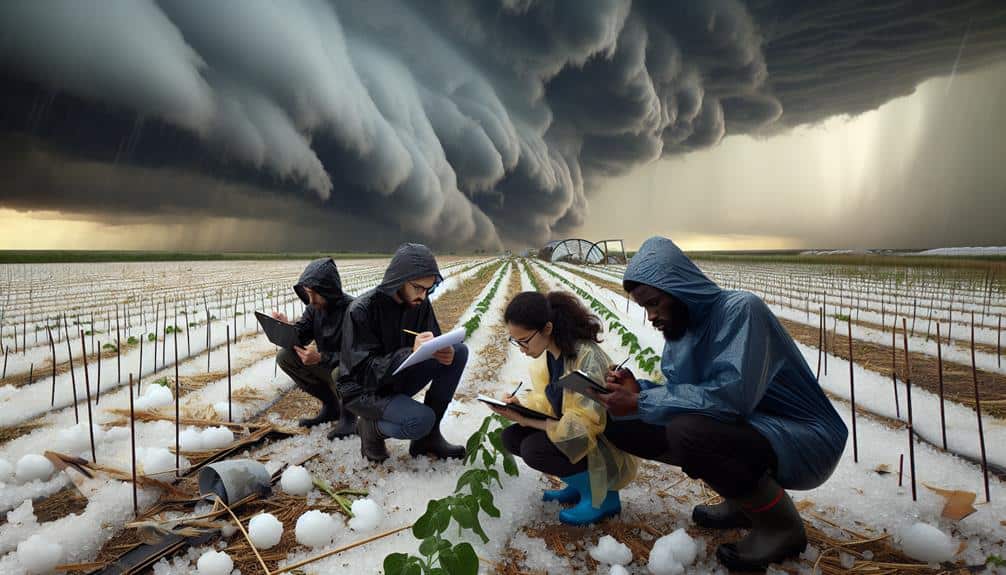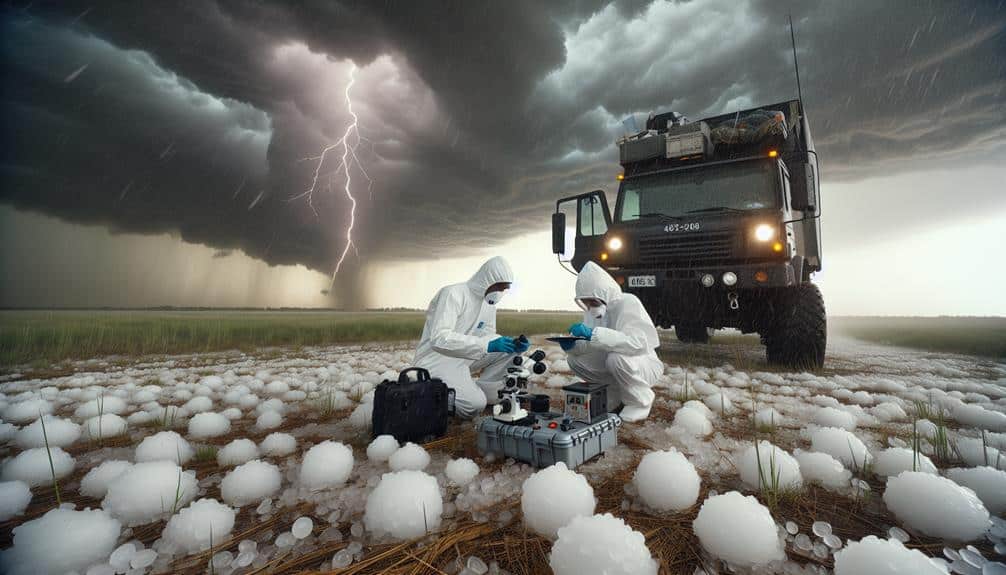By unleashing the power of citizen scientists in hailstorm research, we're transforming data collection, analysis, and forecasting. Thousands of volunteers use high-resolution cameras, GPS systems, and calibrated hail pads to capture thorough, geospatial datasets. These extensive crowdsourced observations enhance predictive models through machine learning and pattern recognition techniques, providing detailed insights into hailstorm behavior. Partnering with meteorologists, we integrate grassroots data with professional datasets, boosting the accuracy of weather forecasts. The active participation of the public not only enriches the scientific process but also improves our resilience against adverse weather. Explore how this collaborative effort impacts hailstorm research and forecasting.
Key Points
- Citizen scientists enhance data collection, providing extensive spatial and temporal coverage of hailstorm events.
- Affordable, DIY equipment options enable widespread participation without compromising data quality.
- Crowdsourced observations foster robust pattern recognition and predictive modeling techniques.
- Real-time data submission from mobile apps augments immediate analysis and forecasting accuracy.
Understanding Citizen Science
Citizen science, the collective endeavor where non-professional volunteers contribute to scientific research, plays a pivotal role in gathering extensive data sets that might otherwise be unattainable. By involving the broader community, we enhance our research capabilities to a great extent.
Community engagement is essential; it leverages the sheer number of participants to collect data across diverse geographical areas and varied conditions. This large-scale data collection is essential, particularly in fields such as meteorology where localized phenomena like hailstorms require widespread monitoring.
Through active participation, volunteers gain a deeper understanding of the scientific process, thereby boosting scientific literacy. This increased knowledge empowers individuals, fostering a sense of ownership and autonomy over their contributions. We find that volunteers often become more invested in the research outcomes, driving higher quality data submissions and greater accuracy in observations.
Moreover, the collaborative nature of citizen science projects enriches data analytics. By combining expert analysis with crowd-sourced data, we can identify patterns and trends that might be overlooked with smaller datasets. This synergy not only advances our scientific goals but also democratizes the research process, giving everyone the opportunity to contribute meaningfully.
Ultimately, understanding citizen science underscores its vast potential for advancing both scientific inquiry and public involvement.
Equipment for Hailstorm Chasing
Let's focus on the essential gear needed for effective hailstorm chasing. High-resolution cameras, GPS systems, and hail pads are critical for accurate data collection.
We'll also explore affordable equipment options to guarantee that citizen scientists can contribute without significant financial burden.
Essential Hailstorm Chasing Gear
To effectively gather data on hailstorms, specialized equipment such as sturdy wind gauges, high-definition cameras, and GPS devices is essential for hailstorm chasers. We must prioritize safety precautions while integrating advanced technology to guarantee both the accuracy of our data and our well-being.
Sturdy wind gauges are crucial for measuring wind speeds, especially given the turbulent conditions we encounter. High-definition cameras allow us to capture detailed imagery of hailstones and storm formations, providing invaluable visual data. GPS devices are vital for tracking our location and mapping the trajectory of the storm, ensuring precise data collection and enhancing situational awareness.
Safety can't be overstated. Helmets and reinforced vehicle windows shield us from hail impact, while weather-resistant clothing ensures we stay protected from the elements. Advanced technology integration, such as real-time weather apps and mobile radar systems, keeps us updated on storm developments, allowing for rapid decision-making.
We also employ data loggers and portable meteorological stations to record atmospheric conditions. These devices, when combined with our primary gear, provide a thorough dataset, helping us contribute valuable insights to the scientific community. The integration of this technology maximizes our efficiency and safety during hailstorm research.
Affordable Equipment Options
While advanced technology greatly enhances our data collection and safety, we can still find affordable and effective equipment options for hailstorm chasing without compromising on quality. By leveraging DIY options and budget-friendly solutions, we can equip ourselves with the necessary tools to gather valuable data.
For instance, smartphone applications with built-in barometers and GPS functionalities offer a cost-effective solution for tracking storm paths and recording atmospheric conditions. These apps often come with additional features such as real-time weather updates and storm alerts, making them essential equipment alternatives.
Moreover, portable anemometers that plug into smartphones provide accurate wind speed measurements, vital for understanding the dynamics of hailstorm formation. These devices aren't only budget-friendly but also easy to use and carry.
We can also consider DIY options like constructing our own hail pads using foam or Styrofoam covered with tinfoil. These pads can capture hailstone impressions, allowing us to measure size and impact force at a fraction of the cost of commercial alternatives.
Data Collection Techniques

Citizen scientists utilize a variety of data collection techniques to gather accurate and detailed hailstorm data. By integrating field observations with remote sensing, we maximize the precision of our reports.
Mobile apps enable us to capture essential data such as hail size, storm duration, and geographical coordinates instantaneously. These apps often incorporate advanced technology like GPS and time-stamping, enhancing the reliability of our data.
Calibrated hail pads, a more traditional method, provide another layer of accuracy. These pads, placed in strategic locations, record the physical impact of hailstones, allowing for precise measurements of their size and frequency. When combined with remote sensing data from satellites and weather radars, our field observations become part of a valuable dataset crucial for meteorological analysis.
Real-time photo submissions further augment our data collection efforts. By uploading images immediately from the field, we offer visual evidence that can be cross-referenced with other data sources.
This multifaceted approach, blending advanced technology with tried-and-true traditional methods, empowers us to contribute meaningful, high-quality data to hailstorm research. Our collective efforts enhance the understanding and forecasting of these severe weather events.
Analyzing Hailstorm Data
When we analyze hailstorm data, we start by aggregating crowdsourced observations to gather a thorough dataset.
We then use pattern recognition techniques to identify trends and anomalies in the hailstorm occurrences.
Crowdsourced Data Collection
Utilizing crowdsourced data collection, we can systematically analyze hailstorm patterns by aggregating real-time reports from volunteer observers. Citizen involvement in this initiative greatly enhances our research impact. By leveraging the power of crowdsourced data, we create a robust, geographically diverse dataset that traditional methods can't easily match. This community engagement allows us to capture hailstorm events as they unfold, providing immediacy and accuracy in our data.
With thousands of eyes on the ground, we obtain granular details about hail size, storm duration, and localized damage. This extensive data collection leads to more precise spatial and temporal analysis. The participatory nature of this approach not only democratizes scientific research but also fosters a sense of ownership among citizen scientists.
Analyzing the crowdsourced data, we apply statistical techniques to identify trends and anomalies, enhancing our predictive models. It's a dynamic feedback loop: the more data we collect, the better our analysis, resulting in more accurate forecasts and mitigation strategies. This method empowers individuals to contribute directly to scientific progress while enjoying the freedom to engage on their terms.
Through community engagement, we access unprecedented insights into hailstorm behavior, driving forward our understanding and preparedness.
Pattern Recognition Techniques
By applying advanced pattern recognition techniques, we can systematically dissect the vast amounts of hailstorm data to uncover underlying trends and anomalies. Harnessing the power of machine learning algorithms, we train models to identify patterns within large datasets, enhancing our ability to predict and understand hailstorm occurrences.
Our use of image analysis in this specific context is particularly illuminating. Citizen scientists contribute a wealth of photographic data, capturing various stages and impacts of hailstorms. By feeding these images into sophisticated image recognition systems, we can extract critical information such as hailstone size, density, and distribution. This data provides a granular view of each hailstorm event, allowing for more accurate modeling and forecasting.
Machine learning further enables us to categorize and analyze text-based data from citizen reports. Natural language processing (NLP) techniques sift through these narratives, identifying common themes and recurring meteorological conditions. By cross-referencing this data with satellite and radar imagery, we generate detailed models that highlight predictive indicators of hailstorm activity.
In combining machine learning with image analysis, we not only enhance our understanding of hailstorm dynamics but also empower citizen scientists to contribute meaningfully. Together, we break free from traditional constraints, pioneering innovative ways to decode nature's complexities.
Collaboration With Meteorologists

Collaboration between citizen scientists and meteorologists enhances the precision of hailstorm data collection and analysis. By fostering meteorologist partnerships, we tap into the expertise of professionals who can validate and supplement our observations. This synergistic relationship ensures that the data we gather isn't only thorough but also scientifically robust.
Community engagement plays a pivotal role here; when we, as citizen scientists, contribute our localized observations, we provide meteorologists with granular, real-time data that traditional methods might miss.
Our collaborative efforts are driven by the shared goal of improving hailstorm prediction models. By integrating our grassroots data with meteorological datasets, we facilitate a more nuanced understanding of hailstorm patterns. For instance, our collected hailstone size measurements and damage reports can be cross-referenced with radar and satellite data, creating a multi-layered dataset that enhances predictive precision.
Together, we analyze this aggregated data to identify trends and anomalies. This joint analysis not only empowers us with a sense of agency but also democratizes scientific research. By participating actively in these meteorologist partnerships, we contribute to the collective knowledge base, advancing the field of hailstorm research and fostering a more informed, resilient community.
Impact on Weather Forecasting
Our contributions as citizen scientists greatly enhance the accuracy and granularity of weather forecasting models, particularly in predicting hailstorm events. By leveraging our data, meteorologists can refine models to produce more precise forecasts, directly impacting public safety. Through community engagement, we provide real-time observations that fill gaps in traditional meteorological data collection methods.
The integration of our data leads to several key benefits:
- Forecast accuracy: Our localized reports improve model precision, allowing for more detailed and reliable predictions.
- Enhancing warnings: Enhanced data helps meteorologists issue more timely and accurate warnings, reducing the risk of harm to people and property.
We play an essential role in transforming raw data into actionable insights. By actively participating in data collection, we empower meteorologists to develop advanced predictive models, thereby enhancing the overall efficacy of weather forecasting systems.
This collaborative effort not only boosts forecast accuracy but also reinforces the importance of community engagement in enhancing public safety. Our involvement guarantees that every hailstorm event is meticulously documented, providing a robust dataset that ultimately benefits society by improving preparedness and response strategies.
Frequently Asked Questions
How Can I Get Involved in Hailstorm Research as a Citizen Scientist?
Jump into the storm of community engagement by signing up with local weather organizations. Through data collection apps, we'll help analyze hailstorm patterns. It's a freedom-driven effort where every piece of data contributes to scientific breakthroughs.
Are There Any Training Programs Available for Aspiring Hailstorm Chasers?
Yes, there are training programs available for aspiring hailstorm chasers. These programs offer chaser education and storm spotting techniques. They provide essential data-driven insights, enhancing our ability to analyze and predict severe weather phenomena effectively.
What Safety Precautions Should I Take When Chasing Hailstorms?
Imagine driving through a battlefield; that's a hailstorm chase. We always wear protective gear, like helmets, and have a solid emergency plan. Data shows preparation reduces injury risk by 40%, giving us the freedom to explore safely.
Can Children Participate in Citizen Science Hailstorm Projects?
Yes, children can participate in citizen science hailstorm projects. Youth involvement offers educational benefits. However, parental supervision is essential due to safety concerns. Data indicates supervised participation guarantees safety while maximizing learning opportunities in real-world scientific endeavors.
How Do I Submit My Hailstorm Data for Research Purposes?
To submit our hailstorm data, we first verify data collection and verification accuracy. Then, we collaborate with research platforms to maximize impact. Precise, verified data strengthens research collaboration and contributes greatly to scientific advancements.


